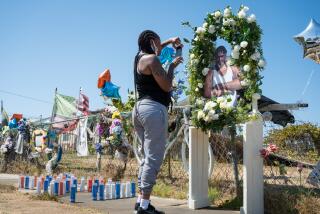A gunshot victim finds cracks in the system
On Valentineâs Day 2009, Danny Rodriguez, then 28, was leaving a party with friends in Pico Rivera when they were accosted by a group of young men from a gang active in the neighborhood. Rodriguez and his friends explained they belonged to no gang and just wanted to go home. But as they drove away, they made a turn down a dead-end street. Gang members followed them, opening fire.
Rodriguez, in the back seat, was the only one hit. The bullet entered the back of his head and exploded into pieces as it drove through his brainâs right parietal lobe and right frontal lobe. A piece of the bullet remains lodged in his skull above his right eye. A 43-year-old La Verne man was arrested and has been charged in the shooting.
At the time, Rodriguez was working on a landscaping crew, with no medical insurance. He was whisked to Los Angeles County/USC Medical Center, where his treatment was largely indistinguishable from that given Rep. Gabrielle Giffords at University Medical Center in Tucson.
To protect the unharmed parts of his brain from further injury due to swelling, Dr. Charles Y. Liu, an associate professor of neurosurgery at USCâs Keck School of Medicine, removed nearly half of Rodriguezâs skull. He cleaned debris from the entry wound and sealed the huge gap in his patientâs cranium to protect the wound from infection. Summoned to the hospital after the surgery was completed, Rodriguezâs mother, Maria, was told the first 72 hours would be the most perilous.
What happened after Rodriguez survived his brain injury is likely to be where the similarities between Rodriguez and Giffords will end. Three weeks after the shooting, still unable to sit in a wheelchair or swallow his own saliva, Rodriguez was transferred to Rancho Los Amigos National Rehabilitation Center, a 395-bed facility in Downey that has 2,300 inpatient admissions a year.
Rancho Los Amigos is a renowned center of innovation in the rehabilitation of patients stricken by disease, stroke and injury. But as the primary rehab facility for indigent and uninsured patients in Los Angeles County, it has been stressed by budget cuts, burgeoning need and the L.A. County/USC Medical Centerâs practice of using Rancho Los Amigos as an overflow facility.
Rodriguezâs stay there was five weeks, his mother says. He was sent back to his foothills community home still incontinent, fresh off a feeding tube and barely able to sit up in a wheelchair. He scribbled his most urgent needs on a white board his mother bought at the Dollar Store.
Six months of outpatient physical and occupational therapy followed â two hours per week. Rodriguez then went eight months without any rehab. Four months ago, the stateâs Medi-Cal program, which now provides his health insurance, agreed to pay for 16 more sessions of physical therapy and 20 more sessions of occupational therapy. Those are to end this week.
His physical therapist has suggested a leg brace would improve his mobility and recommended more rehabilitation. Maria Rodriguez says she learned last week that her application for additional physical and occupational therapy sessions for Danny has been denied.
Rodriguez remains largely paralyzed, partially blind and with reduced sensitivity on his left side. Stabilizing himself with a four-pointed cane, he can walk very slowly, âlike a 90-year-old man,â his mother says. He cannot drive.
Most days, he sits on his couch and watches TV or downloads music on his laptop, waiting for his mother to come home from her job as a medical appointment clerk. He told her recently he was depressed and needed to talk to a professional.
âHeâs just lost interest in almost everything. He feels hopeless,â she says. âHe canât sleep at night. He just sits there and thinks and thinks.â
Danny says he doubts that he will ever be able to live independently or hold down a job. âIt messed me up pretty bad,â he says of the shooting. âMy rehab has been pretty slow, and I have a long way to go before I could do something like ride a bus. Right now, I feel kind of stuck.â
Liu says that, until recently, he did not know what became of most of the gunshot victims he saved in the operating room. But he has become active in encouraging such patients to return to have him surgically restore the normal shape of their heads where the skull had been blown or cut away. He knows fixing that disfiguring reminder of their injury has given patients like Danny, whose cranial reconstruction Liu performed last February, greater confidence in emerging from their homes. Still, he says, he is struck by the no manâs land that many of his low-income patients enter after they leave the hospital.
âFolks who donât have the resources to get better after theyâre discharged, they donât go away,â he says. âAnd we have a moral obligation to take care of these people. If youâre going to spend a dollar to make someone survive, you want to at least spend a dollar to help them go as far as they can afterwards.â
More to Read
Sign up for Essential California
The most important California stories and recommendations in your inbox every morning.
You may occasionally receive promotional content from the Los Angeles Times.











